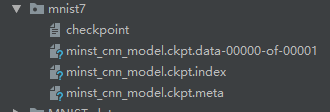卷积神经网络 实现 手写数字识别
根据 mnist 训练集 进行手写数字识别、
#-*- coding: UTF-8 -*-
import tensorflow as tf
#import input_data
# 库中自带
from tensorflow.examples.tutorials.mnist import input_data
# 2. 数据加载
mnist = input_data.read_data_sets('MNIST_data', one_hot=True) # one_hot 编码 [1 000]
sess = tf.InteractiveSession()
x = tf.placeholder("float", shape=[None, 784], name='x') # 输入
y_ = tf.placeholder("float", shape=[None, 10], name='y_') # 实际值
# 初始化权重
def weight_variable(shape):
initial = tf.truncated_normal(shape, stddev=0.1) # 产生正态分布 标准差0.1
return tf.Variable(initial)
# 初始化偏置
def bias_variable(shape):
initial = tf.constant(0.1, shape=shape) # 定义常量
return tf.Variable(initial)
'''
tf.nn.conv2d(input, filter, strides, padding, use_cudnn_on_gpu=None, name=None)
input: 输入图像,张量[batch, in_height, in _width, in_channels]
filter: 卷积核, 张量[filter_height, filter _width, in_channels, out_channels]
strides: 步长,一维向量,长度4
padding:卷积方式,'SAME' 'VALID'
'''
# 卷积层
def conv2d(x,W):
return tf.nn.conv2d(x, W, strides=[1, 1, 1, 1], padding='SAME')
'''
tf.nn.max_pool(value, ksize, strides, padding, name=None)
value: 输入,一般是卷积层的输出 feature map
ksize: 池化窗口大小,[1, height, width, 1]
strides: 窗口每个维度滑动步长 [1, strides, strides, 1]
padding:和卷积类似,'SAME' 'VALID'
'''
# 池化层
def max_pool_2x2(x):
return tf.nn.max_pool(x, ksize=[1, 2, 2, 1], strides=[1, 2, 2, 1], padding='SAME') # 最大池化
# 第一层卷积 卷积在每个5*5中算出32个特征
W_conv1 = weight_variable([5, 5, 1, 32])
b_conv1 = bias_variable([32])
x_image = tf.reshape(x, [-1, 28, 28, 1])
h_conv1 = tf.nn.relu(conv2d(x_image, W_conv1) + b_conv1)
h_pool1 = max_pool_2x2(h_conv1)
# 第二层卷积
W_conv2 = weight_variable([5, 5, 32, 64])
b_conv2 = bias_variable([64])
h_conv2 = tf.nn.relu(conv2d(h_pool1, W_conv2) + b_conv2)
h_pool2 = max_pool_2x2(h_conv2)
# 密集连接层 图片尺寸缩减到了7*7, 本层用1024个神经元处理
W_fc1 = weight_variable([7 * 7 * 64, 1024])
b_fc1 = bias_variable([1024])
h_pool2_flat = tf.reshape(h_pool2, [-1, 7 * 7 * 64])
h_fc1 = tf.nn.relu(tf.matmul(h_pool2_flat, W_fc1) + b_fc1)
# dropout 防止过拟合
keep_prob = tf.placeholder("float", name='keep_prob')
h_fc1_drop = tf.nn.dropout(h_fc1, keep_prob)
# 输出层 最后添加一个Softmax层
W_fc2 = weight_variable([1024, 10])
b_fc2 = bias_variable([10])
y_conv = tf.nn.softmax(tf.matmul(h_fc1_drop, W_fc2) + b_fc2, name='y_conv')
# 训练和评估模型
cross_entropy = - tf.reduce_sum(y_ * tf.log(y_conv))
train_step = tf.train.AdamOptimizer(1e-4).minimize(cross_entropy)
correct_prediction = tf.equal(tf.argmax(y_conv, 1), tf.argmax(y_, 1))
accuracy = tf.reduce_mean(tf.cast(correct_prediction, "float"))
sess.run(tf.global_variables_initializer())
saver = tf.train.Saver()
for i in range(29700):
batch = mnist.train.next_batch(50)
if i % 100 == 0:
train_accuracy = accuracy.eval(feed_dict={x: batch[0], y_: batch[1], keep_prob: 1.0})
print("step %d, training accuracy %g" % (i, train_accuracy))
train_step.run(feed_dict={x: batch[0], y_: batch[1], keep_prob: 0.5})
print(accuracy.eval(feed_dict={x: mnist.test.images, y_: mnist.test.labels, keep_prob: 1.0}))
# 保存模型
saver.save(sess, "D:/Django-workspace/pythonDemo/main/mnist_demo/mnist7/minst_cnn_model.ckpt")
保存训练结果(模型)后, 读取数字图片进行识别

from PIL import Image
import tensorflow as tf
import cv2
def imageprepare():
file_name = '7.png'
myimage = Image.open(file_name)
myimage = myimage.resize((28, 28), Image.ANTIALIAS).convert('L') #变换成28*28像素,并转换成灰度图
tv = list(myimage.getdata()) # 获取像素值
tva = [(255-x)*1.0/255.0 for x in tv] # 转换像素范围到[0 1], 0是纯白 1是纯黑
return tva
result = imageprepare()
init = tf.global_variables_initializer()
saver = tf.train.Saver
with tf.Session() as sess:
sess.run(init)
saver = tf.train.import_meta_graph('mnist7/minst_cnn_model.ckpt.meta') # 载入模型结构
saver.restore(sess, 'mnist7/minst_cnn_model.ckpt') # 载入模型参数
graph = tf.get_default_graph() # 加载计算图
x = graph.get_tensor_by_name("x:0") # 从模型中读取占位符张量
keep_prob = graph.get_tensor_by_name("keep_prob:0")
y_conv = graph.get_tensor_by_name("y_conv:0") # 关键的一句 从模型中读取占位符变量
prediction = tf.argmax(y_conv, 1)
predint = prediction.eval(feed_dict={x: [result], keep_prob: 1.0}, session=sess) # feed_dict输入数据给placeholder占位符
print(predint[0]) # 打印预测结果



